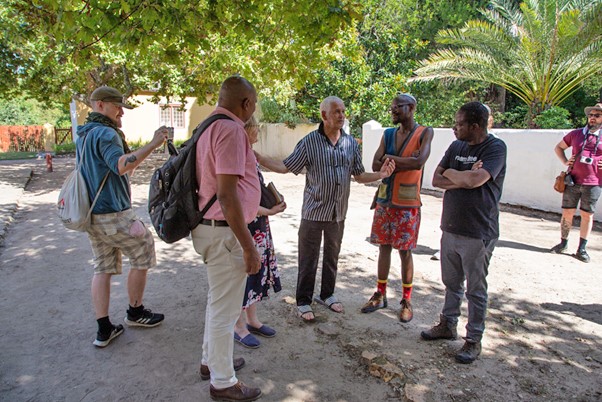The First Mission Station in South Africa
19 juni, 2024
A group of theologians and professors from Stellenbosch University and Åbo Akademi University gathered around Dr Isaac H. T. Balie, who was sitting in the yard of the Moravian missionary station under a big tree. Dr Balie told us about the history of the station and the story of Moravian missionary Georg Smith, and a Khoi woman named Magdalena. On July 9, 1737, a young Georg Smith came to Cape Town to work with the indigenous Khoi people. He settled in the Glen of the Baboons, later known as the Valley of Grace, where he established the first mission station in South Africa. Sadly, he witnessed the mistreatment of the Khoi people by white colonists, who operated within a barter system, leading to widespread impoverishment. Despite these challenges, young Smith taught the Khoi to read, write, and cultivate crops to improve their living conditions. During this era, the Dutch East India Company employed slave labour in South Africa, and the colonizers associated with the Dutch Reformed Church in Cape Town. When Moravian missionary Smith began baptizing his first twenty-eight converts in the Valley of Mercy, the clergy of the Dutch Reformed Church expressed disapproval, believing that Moravian missionaries were not authorized to administer sacraments. This forced him to abandon his work among the Khoi and depart from South Africa.

Dr Balie guiding the group in Genadendal. Photo: Kim Groop
Georg Smith never returned to Africa, but after 48 years, three new Moravian missionaries arrived to carry on Smith’s legacy. They encountered Vehettge Magdalena, who had been baptized by Smith. The young missionary had taught her to read and write, and before his departure, he gifted her a New Testament. Magdalena proudly presented her book to the missionaries and asked a young Khoi girl, whom she had instructed in reading, to read a passage from the New Testament. Magdalena had become one of the church leaders in the Moravian Church when Smith was forced to leave South Africa. From Georg Smith’s diary, we learn that Magdalena was a bright and eager learner. She was intelligent and likely the first indigenous woman in the early 18th century in that region who could read from the Dutch ABC-Book and the New Testament. It is said that Magdalena would gather nearly thirty converts beneath the pear tree, where she would lead them in prayer and read passages from the New Testament. Through the years, she prayed diligently for God to send new Moravian missionaries to the Valley of Mercy, and finally, on Christmas Eve 1792, three ”wise men” from Germany arrived to continue Smith’s work alongside the Khoi. Magdalena served the small congregation for 48 years, reading the New Testament to them. The story of Georg Smith and Magdalena is fascinating but nevertheless true. Could there be more fitting words in the Gospel of Matthew for anyone other than Magdalena: ”Well done, good and faithful servant. You have been faithful and trustworthy over a little, I will put you in charge of many things (Matthew 25:23, AMP).
Marja Segerholm
The theological course Abraham Goes Global is a cooperation between Åbo Akademi University and Stellenbosch University (South Africa) funded by the Finnish National Agency for Education and The Polin Institute 2023-2024 and 2024-2025. The aims are to widen the perception of theology to cross boundaries of religion at both universities, to exchange expertise on contextualised forms of religion, and to deepen the students’ and teachers’ understanding of interreligious and intercultural dynamics in religions. This blog text is the last of six blog texts to present reflections of the Finnish students visiting South Africa in February-March 2024.
